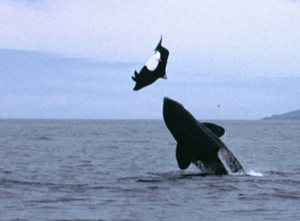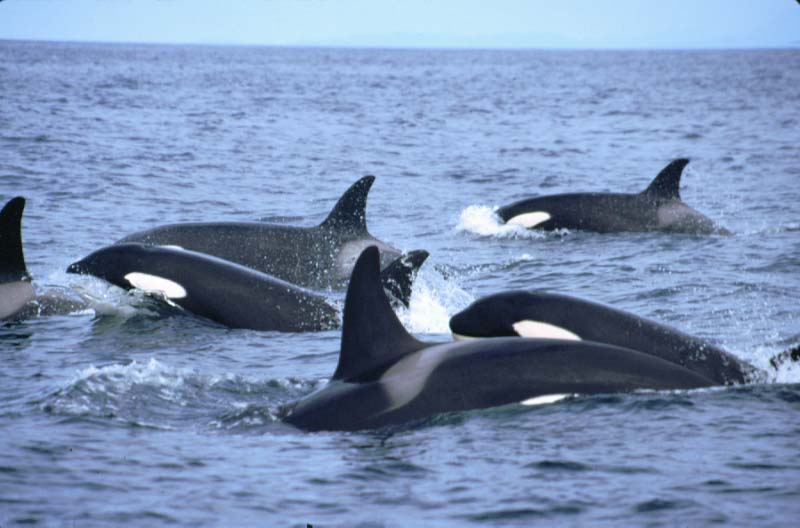



Since 1985 a large proportion of the research I have undertaken has focused on killer whales. My Ph.D. research through Simon Fraser University, completed in 1994, focused on the foraging behaviour and ecology of the mammal-eating transient killer whales, but I have also studied the behaviour of fish-eating residents in Washington, British Columbia and Alaska, as well as the behaviour of killer whales in Iceland. The following is a list of publications and reports on this research, and PDF files are available for many of these.
I am also in the process of writing up several additional papers on killer whales. These focus on the diving and night-time behaviour both of Icelandic killer whales, as well as killer whales in Washington, Alaska and British Columbia, as well as a paper, in collaboration with Dr Janet Mann of Georgetown University, on allomaternal care ("babysitting") in the fish-eating resident population of killer whales from southern Vancouver Island and Washington state.
In 2002, in collaboration with Dr. Brad Hanson of the National Marine Mammal Laboratory, and Greg Marshall and Dr. Mike Heithaus of the National Geographic Television Remote Imaging Program, I began a study of the diet of southern "resident" killer whales. This work uses a combination of suction-cup attached time-depth recorders and video cameras (the National Geographic Television Crittercam system), as well as fish scale-sampling from behind foraging whales, to examine diet. In June and July 2002 we deployed seven TDRs and one Crittercam, obtaining the first underwater video footage collected from a killer whale. Unfortunately the whale was not foraging while the camera was attached, but the video footage (2.8 Meg .mov file, requires Quicktime Player to view) obtained does demonstrate that this technique should be useful to examine underwater feeding.
The killer whale - foraging specializations and group hunting. Introduction of a review chapter on killer whales by R.W. Baird, published in a book in 2000 by the University of Chicago Press.
Status of killer whales in Canada. Paper by R.W. Baird published in the Canadian Field-Naturalist in 2001. Download Adobe PDF copy
Diving behaviour of killer whales. Abstract of a presentation by R.W. Baird, L.M. Dill and M.B. Hanson, to the World Marine Mammal Conference, held in Monaco in 1998.
Information on killer whale reactions to suction-cup tagging can also be found in an Abstract to a presentation at a workshop on "Methods for Assessing Behaviorial Impacts On Marine Mammals from Human Activities", held in Monaco in 1998.
Management of killer whale/boat interactions in Haro Strait. Abstract of a presentation authored by R.W. Baird, R. Otis and R.W. Osborne, from a workshop on "Whale Watching Research" held in Monaco in 1998.
Orca Survey field guide to transients of the Haro Strait area. Text from a catalogue authored by A.M. van Ginneken, D.K. Ellifrit and R.W. Baird, published by the Center for Whale Research, Friday Harbor, WA in 1998.
Birth of a "resident" killer whale off Victoria, British Columbia, Canada. Note by P.J. Stacey and R.W. Baird, published in Marine Mammal Science in 1997. Download Adobe PDF copy
Ecological and social determinants of group size in transient killer whales. Paper by R.W. Baird and L.M. Dill published in Behavioral Ecology in 1996. Download Adobe PDF copy
Levels of organochlorine compounds, including PCDDs and PCDFs, in the blubber of cetaceans from the west coast of North America. Paper by W.M. Jarman and colleagues published in Marine Pollution Bulletin in 1996. Download Adobe PDF copy
Occurrence and behaviour of transient killer whales: seasonal and pod-specific variability, foraging behaviour and prey handling. Paper by R.W. Baird and L.M. Dill published in Canadian Journal of Zoology in 1995. Download Adobe PDF copy
Foraging behaviour and ecology of transient killer whales. Abstract, Prologue, Epilogue and some appendices from the Ph.D. Thesis of R.W. Baird, completed in 1994. Most of the rest of the thesis has been published in journal papers, including the above-noted articles in Behavioral Ecology and Canadian Journal of Zoology, as well as the article noted below in the journal Oecologia.
Possible indirect interactions between transient and resident killer whales: implications for the evolution of foraging specializations in the genus Orcinus. Paper by R.W. Baird, P.A. Abrams and L.M. Dill published in Oecologia in 1992. Download Adobe PDF copy
A review of killer whale interactions with other marine mammals: predation to co-existence. Paper by T.A. Jefferson, P.J. Stacey and R.W. Baird published in Mammal Review in 1991. Download Adobe PDF copy
Observations on the reactions of sea lions, Zalophus californianus and Eumetopias jubatus, to killer whales, Orcinus orca, evidence of "prey" having a "search image" for predators. Paper by R.W. Baird and P.J. Stacey published in Canadian Field-Naturalist in 1989. Download Adobe PDF copy
Variation in saddle patch pigmentation in populations of killer whales (Orcinus orca) from British Columbia, Alaska, and Washington State. Paper by R.W. Baird and P.J. Stacey published in Canadian Journal of Zoology in 1988. Download Adobe PDF copy
Foraging and feeding behavior of transient killer whales. Article by R.W. Baird and P.J. Stacey published in Whalewatcher, the Journal of the American Cetacean Society, in 1988. Download Adobe PDF
Studies of odontocete population structure in Hawaiian waters: results of a survey through the main Hawaiian Islands in May and June 2003. Report by R.W. Baird and colleagues submitted to the National Oceanic and Atmospheric Administration in 2003. While this report does not focus on killer whales, it contains information on a rare sighting of killer whales in Hawaiian waters and information on the genetic identity of one of the whales. Download Adobe PDF copy
For more information on this research write to: rwbaird@dal.ca
Updated November 2003
Photographs on this page (c) Robin W. Baird 2000. Use of photos only with permission of Robin W. Baird
Go to homepage of Robin W. Baird